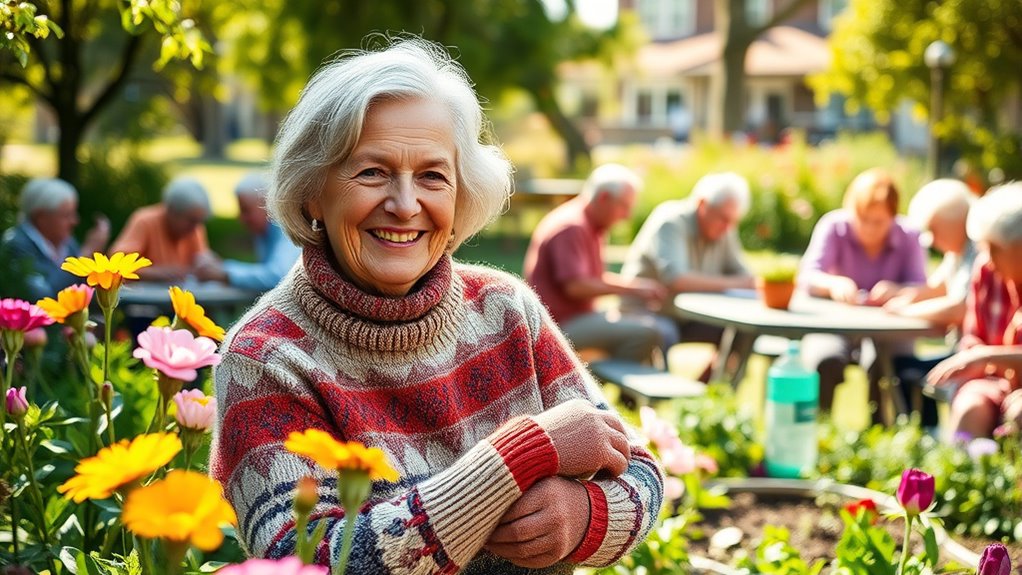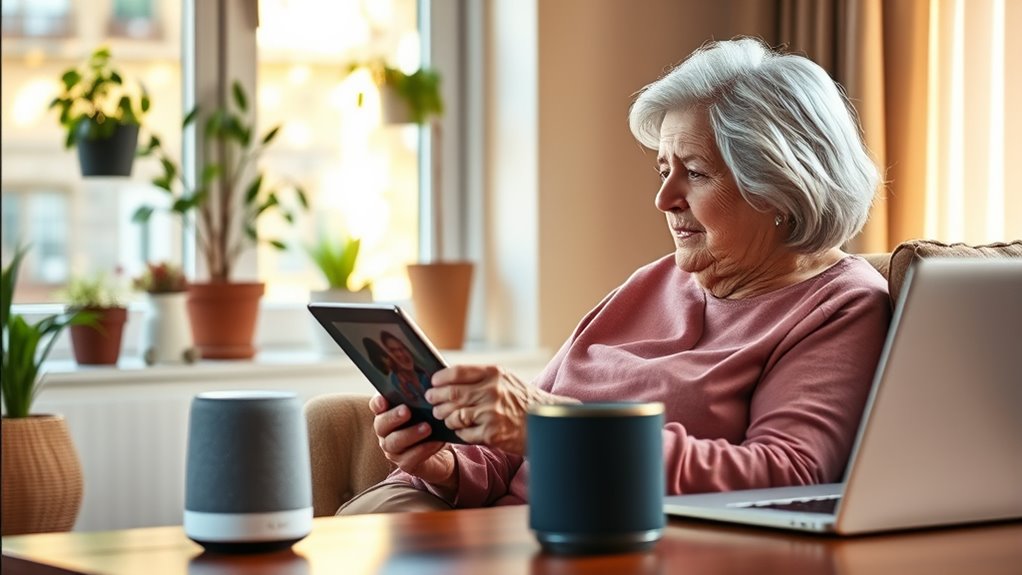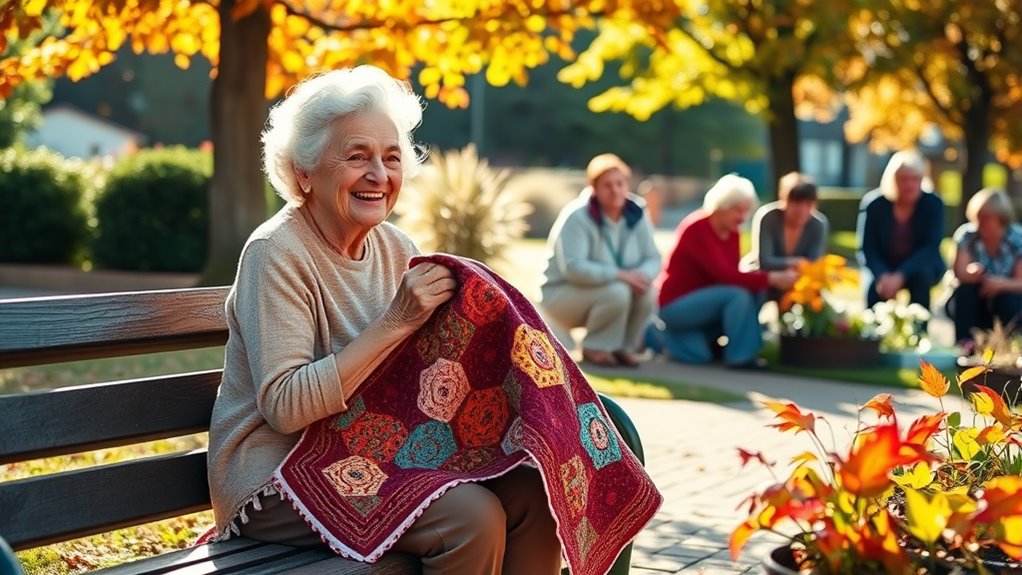To cope with loneliness in later life, recognize signs like withdrawal or mood changes and take proactive steps. Build connections with simple gestures, like greetings or sharing activities, and stay engaged through community groups or hobbies. Use technology, such as phone calls or online platforms, to maintain contact. Establish routines, seek support if needed, and consider volunteering to give your life purpose. Exploring these strategies further can help you feel more connected and fulfilled.
Key Takeaways
- Recognize signs of loneliness early and seek support through community programs or professional counseling.
- Build connections by engaging in social activities, maintaining regular contact, and fostering genuine relationships.
- Use technology like video calls, social media, and online groups to stay connected and reduce feelings of isolation.
- Establish routines and participate in community events or hobbies to create a sense of purpose and belonging.
- Volunteer or give back to others, which enhances emotional well-being and strengthens social bonds.
Recognizing the Signs of Loneliness in Older Adults

How can you tell if an older adult is feeling lonely? Look for signs like withdrawal from social activities or increased quietness. Loneliness often shows through emotional indicators such as persistent sadness, depression, or anxiety. Physical health can also signal loneliness—notice if they experience fatigue, sleep pattern changes, or a decline in overall health. Chronic loneliness can lead to social isolation, reducing chances for meaningful connections and support. You might see them avoiding gatherings or declining invitations. Keep an eye on physical health deterioration, especially worsening chronic conditions, which can be linked to loneliness. Additionally, social engagement levels may decrease, further indicating potential loneliness. Recognizing these signs early helps you understand when an older adult may need extra support to reconnect and combat feelings of loneliness. Monitoring home environment factors, such as the level of mobility and accessibility, can also provide insights into their social interactions and overall well-being. Being aware of the impact of social media can help identify if an older adult is missing out on opportunities for virtual connection and support. Encouraging outdoor activities and physical activity can also help reduce feelings of isolation and boost mental health. Recognizing the importance of outdoor activities and encouraging participation can also play a crucial role in alleviating loneliness.
Building Connections Through Simple Gestures

Smiling at others can open the door to friendly conversations, making social interactions feel more natural. Small gestures like saying hello or asking about someone’s day create a welcoming atmosphere and build trust. Engaging in social engagement practices can also help older adults develop new social habits and boost their confidence in social settings. Maintaining contact through phone calls keeps connections strong, even when you’re apart. Incorporating diverse animated movies into interactions can evoke shared feelings and memories, fostering deeper bonds. Exploring the variety of gelato flavors available at local spots can also serve as a delightful way to connect over shared tastes and experiences. Additionally, understanding industry trends can help older adults identify new opportunities for social participation and engagement.
Smiling Sparks Conversations
A genuine smile can do more than brighten your day; it can open the door to new conversations and connections. For older adults feeling lonely, a simple smile acts as a powerful social signal that encourages positive interactions. It reduces feelings of loneliness by inviting others to engage naturally.
Whether greeting shop staff or waiting with a companion, a warm smile can break the ice and foster rapport. Even if you’re shy, using an authentic smile makes others feel more comfortable and open for conversation. Additionally, practicing mindful decluttering at home can create a calming environment that enhances emotional well-being and openness to social engagement.
Seizing small opportunities to share a smile creates non-verbal invitations to connect. Over time, these simple gestures can lead to meaningful social interactions, building a sense of community and reducing feelings of isolation in later life. Additionally, understanding city dynamics and local tips can help seniors navigate social environments more confidently and find new opportunities to connect.
Furthermore, incorporating self watering plant pots into your home can provide a calming activity that encourages mindfulness and routine, which may help alleviate feelings of loneliness. Engaging in community activities or local events can also expand your social circle and foster new friendships. Recognizing the importance of AI in retail success, community programs can utilize AI-driven tools to connect residents with local events and initiatives, further reducing social isolation.
Inviting Brings Warmth
Offering a simple invitation can create a warm connection that brightens both your day and theirs. When you invite an older neighbor or friend for tea, a walk, or a chat, you’re fostering essential social bonds. Building these connections can also help reduce feelings of social isolation, which many older adults experience. Here are four ways inviting helps combat loneliness:
- It encourages regular social interactions.
- It demonstrates genuine care and builds trust.
- It creates opportunities for meaningful conversations.
- It strengthens feelings of community and belonging.
These small gestures show that you value their presence, which many older adults find uplifting. Inviting someone for a meal or a casual get-together transforms fleeting moments into lasting connections. Additionally, understanding social engagement can enhance your efforts to connect with others and foster a sense of belonging. Engaging in community activities can further deepen these bonds and provide additional support networks, especially when combined with nutrient-rich vegetable juices that promote overall well-being. Incorporating volunteer opportunities into your routine can also expand social networks and provide a sense of purpose, which is vital for emotional health.
Phone Calls Maintain Bonds
Regular phone calls are a simple yet powerful way to maintain meaningful connections with older adults. They foster social connection and reduce feelings of loneliness by providing emotional support and a sense of being cared for. Recognizing the importance of spiritual connections can deepen these bonds, offering a sense of purpose and community. Consistent voice communication with loved ones can lower depression and anxiety, boosting mental well-being. Programs like the Silver Line helpline demonstrate how phone calls can offer companionship, especially for those with mobility issues or limited access to technology. Ensuring that communication methods are trustworthy and reliable is essential for building confidence in these connections trustworthiness of communication. Routine calls help build trust, strengthen social bonds, and remind older adults they’re not alone. These small gestures can make a significant difference in their emotional health, offering reassurance and comfort. Making sure that the communication process remains consistent and dependable can also help in establishing long-term support networks. Recognizing symptoms of breast cancer and encouraging regular screenings can also contribute to overall well-being and peace of mind. Additionally, understanding the cultural context of an individual’s background can enhance the effectiveness of communication and support.
Engaging in Community Activities and Social Groups

Getting involved in community activities and social groups can make a meaningful difference in overcoming loneliness in later life. For older adults, participating in local events, social groups, or faith organizations offers valuable opportunities to build social bonds and improve mental well-being.
Getting involved in community activities helps older adults build social bonds and improve mental well-being.
Consider these options:
- Join a book club or craft class to connect with like-minded peers.
- Participate in walking groups or outdoor exercise classes for physical and social engagement.
- Get involved with regional organizations like the Women’s Institute or Re-engage for structured social events.
- Use helplines such as The Silver Line to discover nearby community programs tailored to your interests.
Regular involvement creates a routine of social interaction that reduces isolation and enhances your overall quality of life.
Engaging in community activities keeps you connected and supported.
Additionally, exploring Pimple Patch options can provide a sense of routine and care, which may positively influence your emotional well-being.
Leveraging Technology to Stay Connected

Using digital communication platforms like Skype or FaceTime lets you see and hear loved ones, easing feelings of loneliness.
Email, social media, and messaging apps help you stay in touch and share updates easily.
Virtual social groups and online forums also offer new ways to connect and engage with others who share your interests.
Digital Communication Platforms
Digital communication platforms like Skype, Zoom, FaceTime, and Viber allow older adults to stay connected with loved ones from afar, helping to combat loneliness. These tools enable meaningful face-to-face interactions through video calls, which can boost emotional well-being and social connectedness.
To make the most of these platforms, you can:
- Master basic digital skills through community courses or library programs.
- Use social media like Facebook, Instagram, and Twitter to reconnect and share updates.
- Join online forums and interest-based websites to meet new people and explore shared hobbies.
- Practice remote communication regularly to maintain relationships and foster a sense of belonging.
Virtual Social Groups
Virtual social groups have become an effective way for older adults to stay connected and combat loneliness, especially when in-person interactions are limited. These groups, hosted on platforms like Zoom, Skype, or Facebook, boost social connectedness and improve mental health. Participating in online communities, such as virtual book clubs or exercise classes, fosters belonging and purpose, reducing feelings of isolation. Data shows that older adults engaging in virtual groups experience mood improvements and fewer depressive symptoms. To maximize benefits, providing training and support in technology use is essential, as it builds confidence and encourages participation. Here’s a quick overview:
| Benefit | Description |
|---|---|
| Reduced loneliness | Regular interaction lowers feelings of isolation |
| Enhanced mental health | Improved mood and well-being |
| Increased social connectedness | Feeling part of a community |
| Accessibility | Reaches those with mobility or remote living challenges |
| Sense of purpose | Engagement fosters belonging |
Maintaining a Routine for Mental and Physical Wellbeing

Have you ever noticed how sticking to a daily routine can boost your mood and help you feel less lonely? A consistent routine provides structure, giving you a sense of purpose and control.
Here are four ways to strengthen your mental and physical wellbeing:
- Establish regular sleep and meal times to improve mood and reduce loneliness.
- Include daily physical activity, like walks or chair exercises, to support mental health.
- Use signals, such as a morning stretch or evening reflection, to mark the start and end of your day.
- Maintain hobbies like reading or gardening to foster a sense of achievement and continuity.
Reaching Out for Support and Professional Advice

Sticking to a routine can help you feel more grounded, but reaching out for support adds an important layer of connection that can further ease loneliness. Support from others boosts your mental health and helps you feel less isolated. Talking to professionals through therapy or counseling can uncover underlying issues like depression or anxiety and develop effective coping strategies. Support lines such as The Silver Line or Age UK offer free, confidential companionship and guidance. Connecting with support groups or trusted friends can provide emotional relief and motivate further social engagement. Consider the options below to find the support you need:
| Support Options | Benefits |
|---|---|
| Support groups | Connect with others facing similar challenges |
| Professional advice (therapy) | Address mental health concerns effectively |
| Support lines (e.g., Silver Line) | Confidential companionship and guidance |
Volunteering and Giving Back to Foster Purpose

Engaging in volunteer work can markedly boost your sense of purpose and reduce feelings of loneliness. When you volunteer, you build social bonds, create meaningful social interactions, and foster a sense of belonging. Consider how:
- Volunteering provides purpose, helping you feel valued and engaged.
- It improves mental health by lowering depression and anxiety risks.
- Participating in community service strengthens existing relationships and helps form new friendships.
- The physical and emotional benefits, like increased serotonin and reduced cortisol, fight loneliness effectively.
For older adults, giving back isn’t just about helping others—it’s about enriching your own life. Volunteering promotes social bonds, enhances mental health, and gives you a renewed sense of purpose, making loneliness less overwhelming.
Developing a Personal Plan to Combat Isolation

Building a personalized plan to combat isolation empowers you to take intentional steps toward meaningful social connection. Start by learning about your loved one’s interests, hobbies, and favorite activities, so you can tailor social engagement strategies that resonate.
Incorporate these activities into daily routines to foster consistency and a sense of normalcy, which helps reduce loneliness. Plan outings like community events, concerts, or group classes to create opportunities for meaningful interactions.
Schedule regular contact, whether through calls, visits, or shared activities, to strengthen emotional bonds and establish a routine connection. Be mindful of mobility and health limitations, ensuring activities remain accessible and enjoyable.
Developing such a personal plan helps older adults stay engaged and connected, enriching their social life and overall well-being.
Frequently Asked Questions
How to Overcome Loneliness in Old Age?
To overcome loneliness in old age, you should stay active socially and mentally. Join community groups, pursue hobbies, or volunteer to meet new people.
Use technology like video calls and social media to keep in touch with loved ones.
Reach out to support helplines for companionship.
Establish a routine that includes physical activity and hobbies, and seek help from a counselor if mental health struggles arise.
How to Cope With Loneliness When You’re Alone?
When you’re alone and feeling lonely, you can take proactive steps to feel more connected. Call or video chat with loved ones regularly, join local or online groups for older adults, or pick up hobbies that keep you engaged.
Establish a daily routine that includes physical activity or volunteering, and practice small acts of kindness like smiling at neighbors.
If needed, reach out to helplines or mental health professionals for support and guidance.
What Does Long-Term Loneliness Do to a Person?
Imagine loneliness as a slow, creeping shadow that darkens your days and dims your spirit. Over time, it can increase your risk of depression, anxiety, and cognitive decline.
It weakens your immune system, raises blood pressure, and can even shorten your life. Long-term loneliness makes it harder to reconnect, trapping you in a cycle of isolation that affects both your mind and body, leaving you feeling more vulnerable and less resilient.
What Are the Later Stages of Life Loneliness Associated With?
In later life, loneliness is linked to factors like losing loved ones, retiring, and having fewer social interactions.
You might experience increased depression, anxiety, and cognitive decline.
Physical health issues like mobility and sensory problems can make socializing harder.
Chronic loneliness also raises your risk of heart disease, high blood pressure, and immune system weakness.
Low income and social marginalization can make these feelings worse, impacting your overall well-being.
Conclusion
Just like tending a garden requires regular care, staying connected keeps loneliness at bay. Imagine your life as a vibrant bloom—each small gesture or new activity helps your well-being flourish. Remember, even a simple call or a shared smile can transform your day. By actively nurturing your social ties, you create a resilient, colorful life full of purpose and joy. Don’t wait—start today and watch your happiness grow.









